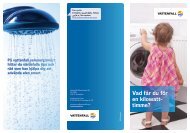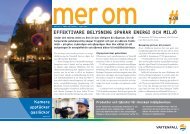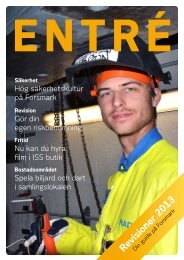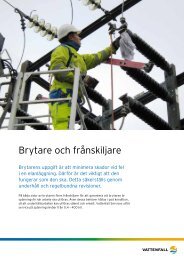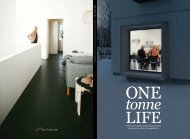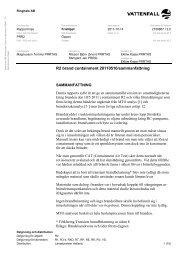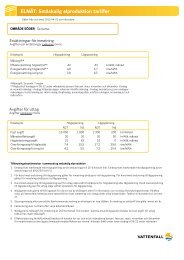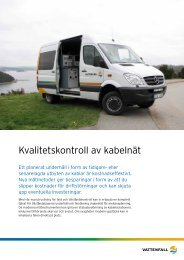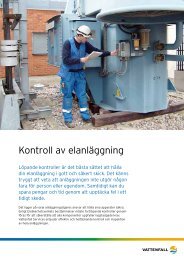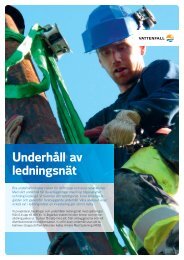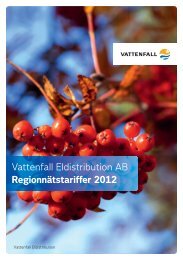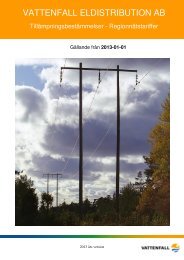This environmental impact assessment for Kriegers flak ... - Vattenfall
This environmental impact assessment for Kriegers flak ... - Vattenfall
This environmental impact assessment for Kriegers flak ... - Vattenfall
You also want an ePaper? Increase the reach of your titles
YUMPU automatically turns print PDFs into web optimized ePapers that Google loves.
panies on marine safety analyses. GL has calculated<br />
a so called basic collision risk, i.e. the risk of a ship<br />
colliding with the wind farm without regard <strong>for</strong> safety<br />
increasing measures. In this scenario, all collisions are<br />
considered, including those where a ship only touches<br />
a wind turbine without causing damage. The basic<br />
collision risk has been calculated to 0,004 collisions<br />
per annum, corresponding to a statistical interval of<br />
251 years. If safety increasing measures are taken into<br />
consideration, the statistical interval between two accidents<br />
increases to over 1 000 years. These numbers<br />
are considerably lower than <strong>for</strong> other wind projects. For<br />
more in<strong>for</strong>mation on the GL analysis, see Attachment<br />
12.1.<br />
The second risk analysis was carried out by SSPA.<br />
The analysis of GL mentioned above and the analysis<br />
that GL has made <strong>for</strong> the wind farm planned in the<br />
German economic zone, has been used as important<br />
basis <strong>for</strong> the SSPA study. SSPA has focused on what<br />
probably interests the public most, namely the risk of<br />
an accident that causes danger to nature or humans,<br />
<strong>for</strong> example through an oil spill. The risk of a collision<br />
that causes an oil spill has been calculated to 0,0006<br />
per annum by the SSPA, or about 1 700 years between<br />
collisions (to be compared to the number calculated <strong>for</strong><br />
the planned wind farm in the German economic zone,<br />
namely 580 years).<br />
The average oil spill has been estimated to be 3<br />
400 tons. With safety increasing measures, such as<br />
standby tugs, the risk is reduced to 0,00015 collisions<br />
per annum or about 6 700 years between collisions (see<br />
Attachment 12.2).<br />
The risk of humans being hurt because the ship<br />
that they are on collides with the wind farm has been<br />
estimated to 0,000002 per annum, or one in every 500<br />
000 years, provided that no safety increasing measures<br />
are taken. A comparison with European ferry trafÞ c<br />
shows that the collision risk between a ferry and the<br />
wind farm is considerably lower. With safety increasing<br />
measures, such as AIS and trafÞ c control, the risk<br />
<strong>for</strong> human accidents reduces to 0,0000005 per annum,<br />
or one every 2 000 000 years.<br />
More details can be found in Attachment 12.2.<br />
12.8.3 Mitigating measures<br />
The safety increasing measures recommended by the<br />
SSPA will be proposed by Sweden Offshore and deci-<br />
CONSEQUENSES OF THE WIND FARM 143<br />
sions in this matter will be taken in consultation with<br />
affected authorities.<br />
12.8.4 Assessment<br />
ASSESSMENT CRITERIA<br />
Very big <strong>impact</strong> (high value – high <strong>impact</strong>)<br />
• The structure is a permanent hazard to international<br />
shipping, i.e. existing shipping lanes<br />
have to be moved (permanent hazard, > one<br />
generation).<br />
Big <strong>impact</strong> (high value – reasonable <strong>impact</strong>/reasonable<br />
value – high <strong>impact</strong>)<br />
• The structure is a temporary hazard to international<br />
shipping, i.e. existing shipping lanes have<br />
to be moved (< one generation).<br />
• The structure is a permanent hazard <strong>for</strong> other<br />
shipping, i.e. ships moving outside of shipping<br />
lanes (> one generation).<br />
Reasonable <strong>impact</strong> (reasonable value – reasonable<br />
<strong>impact</strong>)<br />
• The structure has an <strong>impact</strong> on international<br />
shipping, i.e. disturbs the traffi c compared<br />
with today.<br />
• The structure is a temporary hazard <strong>for</strong> other<br />
shipping, i.e. ships moving outside shipping<br />
lanes.<br />
Small <strong>impact</strong> (reasonable risk – minor <strong>impact</strong>/minor<br />
risk – reasonable <strong>impact</strong>).<br />
• The structure has little <strong>impact</strong> on international<br />
shipping, i.e. disturbs traffi c a little compared<br />
with today.<br />
• The structure causes <strong>impact</strong> on other shipping,<br />
i.e. ships that move outside of shipping lanes.<br />
Minor/no <strong>impact</strong> (minor value – minor <strong>impact</strong>)<br />
• The structure has minor or no <strong>impact</strong> on shipping<br />
in the area.<br />
Conclusion<br />
As shipping lanes are at a safe distance, the wind farm<br />
will cause little <strong>impact</strong> <strong>for</strong> international shipping.<br />
The wind farm will be a temporary hazard <strong>for</strong> trafÞ c<br />
outside the shipping lanes. <strong>This</strong> is however dependent<br />
on that trafÞ c will be <strong>for</strong>bidden within the wind farm<br />
area.




